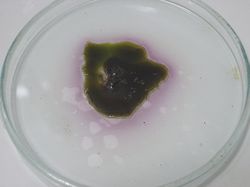Manganese heptoxide
 Freshly prepared manganese heptoxide. Photo by woelen.
| |
| Names | |
|---|---|
| IUPAC name
Manganese(VII) oxide
| |
| Other names
Dimanganese heptoxide
Manganic oxide Permanganic oxide | |
| Properties | |
| Mn2O7 | |
| Molar mass | 221.87 g/mol |
| Appearance | Dark red oil Green if in contact with sulfuric acid |
| Odor | Odorless (may release ozone during preparation) |
| Density | 2.396 (20 °C) 2.79 g/cm3 (-30 °C) |
| Melting point | 5.9 °C (42.6 °F; 279.0 K) |
| Boiling point | Detonates above 55 °C |
| Hydrolyzes to permanganic acid | |
| Solubility | Reacts with most organic solvents Immiscible with carbon tet, nitromethane |
| Thermochemistry | |
| Std enthalpy of
formation (ΔfH |
739.2 kJ/mol |
| Hazards | |
| Safety data sheet | None |
| Related compounds | |
| Related compounds
|
Manganese dioxide |
| Except where otherwise noted, data are given for materials in their standard state (at 25 °C [77 °F], 100 kPa). | |
| Infobox references | |
Manganese heptoxide, also known as permanganic anhydride, is a dark green, extremely oxidizing manganese compound with the formula Mn2O7. It will set nearly any organic material on fire, and may explode on contact with metals. It tends to decompose to form manganese dioxide, oxygen and ozone. In hot environments, this may also occur explosively. This compound is not recommended for production and use except by chemists with adequate experience in handling such compounds.
Contents
Properties
Chemical
Manganese heptoxide is an energetic material and will ignite nearly anything it contacts, including ethanol, acetone, cotton, polystyrene, aluminium and bread (albeit with great difficulty). It will explode, even without a fuel, on warming to 95 °C. It produces ozone when it decomposes and this can ignite a piece of paper impregnated with alcohol.
Manganese heptoxide does not ignite nitromethane.
Physical
The pure compound is a brown liquid with melting point 5.9 °C. It forms violet vapors if warmed to 40-50 °C and explodes at higher temperatures. Solutions in sulfuric acid are dark green, and this is the most commonly prepared form.
Production
Impure manganese heptoxide can be prepared by the addition of concentrated sulfuric acid to solid potassium permanganate. The resulting green liquid is manganese heptoxide dissolved in sulfuric acid, with potassium bisulfate impurities. Always have a bucket with water or sand nearby when doing this reaction. This should only be performed by those with adequate experience and should only be performed on a sub-gram scale.
When a lower concentration of sulfuric acid, such as 80%, is used, the green liquid does not form. Instead you get a concentrated solution of permanganic acid, which quickly decomposes, liberating oxygen and ozone. This reaction, if done carefully, can be used as a method to synthesize ozone.
Projects
- Make permanganic acid
- Make instant fire
Handling
Safety
Manganese heptoxide sets nearly all reducing agents on fire. It's an oxidizer, so a manganese heptoxide fire cannot be deprived of oxygen to stop it. It is also known to be able to explode on its own, so large quantities should never be prepared. The decomposition of manganese heptoxide produces copious amounts of ozone.
Storage
Manganese heptoxide cannot be stored safely. It will slowly decompose and may explode spontaneously.
Destruction
Manganese heptoxide can be destroyed by quenching in water, preferably adding a solution of sodium hydroxide afterwards. The water will convert the manganese heptoxide to permanganic acid, which is far less dangerous, and the sodium hydroxide will neutralize any remaining sulfuric acid.
References
- Encyclopedia of Explosives and Related Items - Volume 8, 1978.
- Manganese heptoxide, Wikipedia (http://en.wikipedia.org/wiki/Manganese_heptoxide).